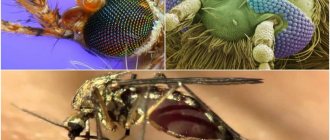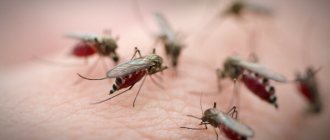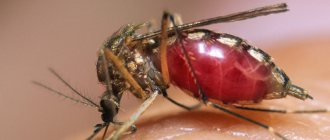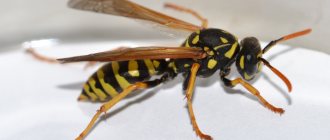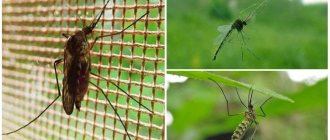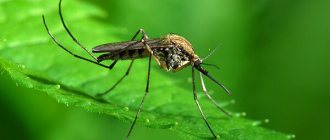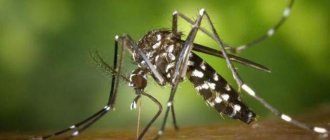| Mosquitoes | ||
| Scientific classification | ||
| intermediate ranks Domain: | Eukaryotes | |
| Kingdom: | Animals |
| Sub-kingdom: | Eumetazoans |
| Without rank: | Bilaterally symmetrical |
| Without rank: | Protostomes |
| Without rank: | Shedding |
| Without rank: | Panarthropoda |
| Type: | Arthropods |
| Subtype: | Tracheal breathing |
| Superclass: | Hexapods |
| Class: | Insects |
| Subclass: | Winged insects |
| Infraclass: | New-winged insects |
| Treasure: | Insects with complete metamorphosis |
| Superorder: | Antliophora |
| Squad: | Diptera |
| Suborder: | Long mustache |
| Infrasquad: | Culicomorpha |
| Superfamily: | Culicoidea |
| Family: | Mosquitoes |
- Culex
- Aedes
- Culiseta
- Anopheles
and others. See text.
| NCBI | 7157 |
| EOL | 473 |
| 138308 |
Common mosquito ( Culex pipiens
)
Yellow fever mosquito (
Aedes aegypti
) on a victim
Mosquitoes
, or
true mosquitoes
[1], or
blood-sucking mosquitoes
(lat. Culicidae) are a family of dipterous insects belonging to the group of long-whiskered insects (
Nematocera
), the female adults of which in most cases are a component of the midge complex.
The oral organs are characteristic of this family: the upper and lower lips are elongated and form a case in which long thin needles are placed (2 pairs of jaws); Males have underdeveloped jaws - they do not bite. Mobile larvae and pupae of mosquitoes live in stagnant bodies of water. Fossil mosquitoes have been known since the Cretaceous period. In the modern world, there are more than 3,000 species of mosquitoes belonging to 38 genera[2]. Russia is home to representatives of 100 species[2], belonging to the genera of true mosquitoes ( Culex
), biters (
Aedes
),
Culiseta
, malaria mosquitoes (
Anopheles
),
Toxorhinchites
,
Uranotaenia
,
Orthopodomyia
,
Coquillettidia
.
The life cycle of mosquitoes includes four stages of development: egg → larva → pupa → adult, or adult.
Area
Additional information: Area
Mosquitoes are widespread throughout the globe and inhabit all continents except Antarctica[5]. The widest range of the common mosquito ( Culex pipiens)
), which is distributed everywhere where a person is found - its main victim. In warm and humid tropical regions they are active throughout the year, but in temperate regions they overwinter as adults during the cold season. Arctic mosquitoes remain active for only a few weeks a year, when heat causes thermokarst pools of water to form on top of the permafrost. However, during this time they manage to breed in huge quantities - swarms of mosquitoes can take up to 300 ml of blood per day from each animal in the caribou herd[6]. The eggs of mosquitoes living in temperate latitudes are more resistant to the negative effects of cold than the eggs of mosquitoes common in warmer climatic zones[7][8]. They can even withstand exposure to snow and freezing temperatures. In addition, adult individuals can survive throughout the winter in habitats suitable for their wintering (for example, warm and humid basements of residential buildings)[9].
Distribution media
Humans have contributed to the spread of various species of mosquitoes throughout the world and their movement over long distances into regions where they are not native. First of all, these are journeys along sea routes, in which eggs, larvae and pupae of mosquitoes are transported in worn-out tires filled with water or containers with cut flowers. However, in addition to sea transport, mosquitoes have actively mastered travel on personal vehicles, trucks, trains and even airplanes. Thus, the spread of mosquitoes is difficult to control, and even quarantine measures have proven to be ineffective and difficult to implement in practice.
Morphological description
Mosquitoes are insects with a thin body (4-14 mm long), long legs and narrow transparent wings (wingspan from 5 to 30 mm). The body color of most species is yellow, brown or gray, but there are black or green-colored species. The abdomen is elongated, consisting of 10 segments. The chest is wider than the abdomen. The paws end in a pair of claws. The wings are covered with scales, the accumulations of which sometimes form spots. The antennae are long and consist of 15 segments. The mouthparts are piercing-sucking type. In females, the proboscis is long and consists of piercing bristles, in males it is without them [10] [11].
The oral apparatus is hidden in the tube-shaped lower lip. Inside it there are several saw-like stiletto-like jaws (lower jaws - lower jaws and high jaws - upper jaws). With its jaws, the mosquito cuts a hole in the skin, immerses the proboscis deeper to the level of the blood capillaries, and through the same oral appendages, as if through a collecting tube, it sucks blood without having a sucking mechanism.
Not to be confused:
Insects from the family of centipedes, which have similar legs and the shape of their wings, are sometimes mistaken for huge mosquitoes.
Description of the mosquito
Mosquitoes , or blood-sucking mosquitoes , or true mosquitoes (Culicidae) are a family of dipterous insects belonging to the long-whiskered group (Nematocera), which includes: true mosquitoes, long-legged mosquitoes, butterflies, midges. They differ from their relatives in the order Diptera - flies - in origin, structural features and way of life. In the modern world, there are more than 3,000 species of mosquitoes belonging to 38 genera. In Russia you can find representatives of 100 species belonging to the genera of true mosquitoes (Culex), biters Culiseta, (Aedes), malaria mosquitoes (Anopheles), Uranotaenia, Toxorhinchites, Orthopodomyia, Coquillettidia.
Female adult mosquitoes are in most cases a component of the mosquito complex.
Mosquitoes are widespread throughout the globe and inhabit all continents except Antarctica. The widest distribution area is the common mosquito (Culex pipiens), which can be found everywhere where people live - its main victim.
Structure of a mosquito
The body structure of mosquitoes is the same in all species. They differ mainly in size and color. The mosquito's body is thin, 4-14 mm long. The abdomen is narrow, elongated, consisting of 10 segments. The chest is wider than the abdomen. Three pairs of thin legs end in a pair of tiny claws. The antennae are long and consist of 15 segments. The mosquito has two transparent wings covered with scales, the accumulations of which sometimes form spots.
The oral apparatus is of a piercing-sucking type, transformed into a proboscis, consisting of a lower and upper lip, two lower and two upper jaws, and a subpharyngeal gland. It is hidden in the tube-shaped lower lip. In females the proboscis is long and consists of piercing bristles, in males it is without them. The length of the trunk significantly exceeds the size of the head.
With its jaws, the mosquito cuts a hole in the skin, plunges the proboscis deeper to the level of the blood capillaries, and through the same oral appendages, as if through a collection tube, it sucks blood. Males have underdeveloped jaws - they do not bite.
What do mosquitoes look like?
Not all mosquitoes are gray; there are species that are more brightly colored. Mosquitoes from the genus Sabethes (Sabethes) of the family True mosquitoes are very beautiful. These insects live in Paraguay and French Guiana. They are shiny, greenish-blue, with lush brushes on their legs. Among the long-legged mosquitoes there are yellow, orange, black and yellow ones. Some mosquitoes are fluffy, and even their wings are fluffy. Some are wingless, their wings were lost in the process of evolution.
Life cycle of a mosquito.
Classification
Within the family there are three subfamilies:
- Subfamily Malaria mosquitoes ( Anophelinae
) Genus Malaria mosquitoes (
Anopheles
) - Genus Bironella
- Genus Chagasia
)
- Tribe Culicini
Genus Biters (
Aedes
)
)
, formerly
Theobaldia
)
- Genus Johnbelkinia
[12][
not in source
]
- Genus Toxorhynchites
Mosquito feeding
Mosquitoes feed on nectar
Typically, male and female mosquitoes feed on nectar and plant juices, but in many species the females have mouthparts adapted to pierce the skin of their host animals to suck their blood (ectoparasitism). In some species, the female must obtain nutrients from the prey's blood before she can produce eggs, while in many other species, after feeding on blood, females gain the ability to produce more eggs. Both food sources (plant materials and animal blood) in the form of sugars (carbohydrates) provide energy for the mosquito. In addition, blood is a source of more concentrated and beneficial nutrients such as lipids, but the most important role of blood in the mosquito diet is to provide proteins as a building block for egg production. Thus, there is a certain specialization: female mosquitoes feed on blood to reproduce full-fledged offspring, and males refrain from parasitic feeding on the blood of victims. A similar picture is observed in representatives of some other families of insects, for example, horseflies.
For most species of mosquitoes, the source of blood (“feeders”) are warm-blooded vertebrates: mammals and birds. But some species are able to feed on the blood of reptiles, amphibians and even fish.
Most of the olfactory organs or olfactory system
The mosquito specializes in searching for (“sniffing out”) sources of blood: of the 72 types of olfactory receptors located on the mosquito’s antennae, at least 27 are configured to detect chemicals released in the sweat of animals and humans[13][14].
Aedes
mosquitoes, the search for a victim (host) occurs in two stages: perception of the specific behavior of the object (movement), perception of its chemical and physical characteristics[15].
Anatomy
The mosquito insect is distributed throughout the world, there are more than 3000 species, 38 genera. All have a similar structure, but differ in body size. They write a lot about mosquitoes in various sources; they study insects at school. The body structure is simple - head, chest, abdomen.
Head structure
The mouthparts of a mosquito deserve special attention. Includes upper, lower elongated lip, jaws. Inside the lips there is a groove with 12 needles. The jaws and tongue create a cavity for the passage of saliva.
One pair of long spines has projections called teeth. There are 50 of them in total. The insect tears the skin with its teeth. The next pair of needles acts as forceps and holds the wound open. The remaining needles hold the mosquito's proboscis and facilitate the flow of food. The long nose does not go completely under the skin, but reaches the blood vessels.
Female mosquitoes feed on blood. The insect injects saliva, which contains an anticoagulant that thins the blood. This prevents lymph from clotting and ensures a long supply of food. At one time, the female is capable of drinking about 5 ml of blood, with her own weight of 3 g; the number of bites depends on the behavior of the victim. The long nose of the male mosquito provides it with food from flower nectar and pollen.
Lifestyle
Typically, in the temperate zone, mosquitoes are active from May to October. If there was a lot of snow in the winter, and the spring is early, consistently warm and moderately humid, mosquitoes may appear as early as April.
Like all other dipteran insects, mosquitoes have 4 developmental phases: egg, larva, pupa, and adult. Moreover, all phases, except adults, live in reservoirs. Mosquito larvae and pupae living in water breathe atmospheric air through breathing tubes, exposing them to the surface. Mosquito larvae - filter feeders or scrapers - feed on aquatic microorganisms. The feeding of adults is often dual: females of most mosquito species drink the blood of vertebrates: mammals, birds, reptiles and amphibians; at the same time, the males of all species of mosquitoes, without exception, feed on the nectar of flowering plants. However, representatives of the subfamily Toxorhynchitinae
have predatory larvae, while their adults (both males and females) feed exclusively on nectar.
In summer, adult females of blood-sucking mosquitoes are found both in nature in swampy and damp places, and in animal premises, in human homes on walls, windows, and shaded places. In winter, they can be found in livestock buildings, warm basements, and other buildings, where they are in an inactive state, or in torpor (if the temperature is below 0 °C) [10].
When choosing a victim, the female blood-sucking mosquito focuses on the smell of lactic acid contained in sweat [16] (several kilometers), on carbon dioxide exhaled by a person (hundreds of meters) and on thermal radiation (several meters), on movement, and also the female mosquito reacts to light, preferring dimly lit rooms, which is why in city apartments females are mainly nocturnal.
The average lifespan of a female C. p. pipiens f. molestus
depends largely on temperature. In laboratory conditions (such observations were not carried out in basements), on carbohydrate nutrition at 25 °C females live on average 43 days, at +20 °C - 57 days, and at +10...+15 °C - 114-119 days; In the absence of food, life expectancy is greatly reduced. The lifespan of males in all cases is much shorter, so at +25 °C it is only 19 days.
A completely different picture is observed in mosquitoes of the pipiens
, which under certain circumstances can become long-lived.
If the females hatched from pupae in July - early August, then they all diapause and go to wintering, which lasts until March - May; After wintering ends, they reproduce and live for another 1-2 months. In total, the life expectancy of such females is about a year. By comparison, the lifespan of Aedes
, which diapause during the egg stage, is much shorter: they are born in the spring, reproduce, and die by the fall.
The pupae are mobile. The respiratory openings of the pupa are not located on the abdomen, as in larvae and adults, but on the upper side of the chest, which the insect holds near the surface during breathing, and through which the mature adult emerges. On the empty shell of the pupa, the insect waits until its wings dry out before flying.
Life cycle of an anomaly mosquito
After mating, the Anopheles female looks for a feeder and drinks blood. Then it hides in thickets of grass, bushes, in a dark place, the blood is digested, and the eggs mature. At one time, the female lays from 60 to 350 eggs.
The eggs float on the water due to air chambers called floats.
The larvae of the malaria mosquito lead an aquatic lifestyle and their bodies are located parallel to the water surface, and not at an angle, like in squeaks, since they do not have a respiratory siphon. They feed on plant remains and bacteria.
Pupae have respiratory siphons, they are located on the back. The rudiments of wings, legs, and mouthparts are visible through the integument of the pupa.
An adult insect has an elongated abdomen, narrow wings with spots, and a breast protruding forward. The head has tentacles and proboscis of the same size. The common squeaker has antennae - tentacles less than a quarter of the length of the proboscis, which makes it different from Anopheles.
Anopheles lives on average one month. Males die in the fall, and females spend the winter in cellars, basements, and damp places. The females are fertilized, in the spring they fly out in search of food, after drinking blood, the process of egg maturation begins.
Reproduction
During the mating period, female mosquitoes attract the attention of males with a characteristic subtle sound, reminiscent of a squeak, which is created with the help of their wings. Mosquitoes detect sound vibrations with their sensitive antennae. Females squeak a little thinner than males, young ones - not as much as old ones. And male mosquitoes hear this and make a choice in favor of adult females. Mosquitoes form a swarm, where males and females mate.
A female mosquito lays 30-150 and sometimes even 280 eggs (in malaria mosquitoes) every two to three days. The egg develops into an adult mosquito within a week. Mosquitoes require blood to reproduce eggs, so the egg laying cycle is directly related to blood consumption. Only some urban subspecies can lay eggs without drinking blood, but they lay very few eggs.
Eggs are laid in stagnant or low-flowing reservoirs on the surface of the water (genus Anopheles
and
Culex
), on moist soil at the edge of water in reservoirs that dry up in summer and are flooded in spring, or stick to floating objects washed by water (in
Culex
)[10]. The eggs on the water surface are connected in the form of a raft. The larva leaves the egg from the lower end.
Mosquito bite
Mosquito bite sites
Before a female mosquito begins to drink blood, she injects saliva into the skin of her victim, which contains anticoagulants that prevent blood clotting. It is the mosquito's saliva that causes itching, swelling, redness at the site of the bite, and in some cases, a severe allergic reaction. And it is through saliva that mosquito-borne infections are transmitted.
Mosquito-borne diseases
Aedes aegypti
- vector of yellow fever and dengue fever
Anopheles albimanus
- a malaria carrier that feeds on blood from a person's hand
Anopheles stephensi
female , who has drunk blood and begins to excrete an excessive amount of liquid blood to make room in the intestines for more solid nutrients
Additional information: carrier
Mosquitoes can act as carriers of diseases dangerous to human health and life - pathogenic bacteria, viruses and parasites. Infected mosquitoes transmit viruses or parasitic organisms from person to person without showing symptoms of the disease themselves. Diseases transmitted by mosquitoes include:
- parasitic diseases under the general name malaria
, caused by parasites of several species of the genus
Plasmodium
(plasmodia), transmitted by mosquitoes of the genus
Anopheles
(Anopheles); - lymphatic filariasis (the main clinical sign is elephantiasis
), which can be spread by a wide range of mosquito species[18]; - viral diseases transmitted by the vector Aedes aegypti
: yellow fever, dengue fever, chikungunya. Dengue fever is the most common cause of fever in travelers returning from the Caribbean, Central America and south central Asia. This disease is transmitted only through the bites of previously infected mosquitoes and cannot be transmitted from person to person. Severe cases of this type of fever can be fatal, but with timely and correct treatment, less than 1% of patients die from Dengue fever; - The problem of West Nile Virus is a concern in the United States, however, there are no reliable statistics on the prevalence of cases of this disease throughout the world;
- spread of eastern equine encephalitis virus is a problem in the eastern United States;
- Tularemia is a bacterial infection caused by Francisella tularensis
and is transmitted in a variety of ways, including through the bites of flies and mosquitoes
Culex
and
Culiseta
, which are carriers of tularemia pathogens, as well as arboviral infections such as West Nile Virus.
Although HIV transmission was initially considered a major public health problem, practical considerations and epidemiological model studies suggest that any transmission of HIV by mosquitoes is, in practice, extremely unlikely (a “worst case”[19]).
Mosquitoes are involved in transmitting various types of disease to more than 700 million people a year in Africa, South America, Central America, Mexico, Russia and much of Asia, with millions of deaths—at least two million people die from these diseases each year. and the incidence rate is many times higher than officially registered.
Methods used to prevent the spread of disease or to protect individuals from mosquitoes in areas where the disease is endemic include:
- vector population control aimed at mosquito control or eradication;
- prevention of mosquito-borne diseases using prophylactic drugs and vaccine development;
- preventing mosquito bites: using insecticides, mosquito nets and repellents.
Since most of these diseases are transmitted by "older" female mosquitoes, some scientists have proposed focusing on them to avoid resistance to evolution[20].
How dangerous are mosquitoes?
The main danger of mosquitoes is that they are carriers of diseases. The development of diseases can be triggered by parasites, viruses and pathogenic bacteria that the bloodsucker carries on its paws and proboscis.
So, what diseases do mosquitoes carry?
- Different types of malaria, which are parasitic diseases. Their causative agents are parasites belonging to the Plasmodium species. Such diseases are carried by mosquitoes belonging to the genus Anopheles, popularly known as malaria mosquitoes.
- Lymphatic filariasis, the symptom of which is elephantiasis. Many types of bloodsuckers can carry this disease.
- Diseases caused by the vector Aedes aegypti. These include chikungunya, yellow fever and dengue fever. The latter most often affects travelers who have visited southern Central Asia, Central America and the Caribbean.
On a note! It is characteristic that Dengue fever can only be transmitted through infected mosquitoes; this disease does not spread from person to person!
Important! About 700 million people annually become infected with various diseases through mosquito bites. Residents of South and Central America, Africa, Mexico, Asia and Russia are most often affected. And at the same time, about 2 million people die from such diseases every year!
Mosquito control
All mosquito repellents can be divided into:
- environmental - improvement of reservoirs, improvement of basements; ecological methods are aimed at creating conditions in cultural landscapes that are not suitable for the development of mosquitoes (draining wetlands, deepening the banks of reservoirs, clearing them of semi-submerged vegetation);
- physical - traps like Velcro, etc., mosquito nets, mosquito nets, canopies (mosquito tent), thick clothing;
- folk - these are plants and their extracts, the smell of which is not tolerated by mosquitoes;
- biological - larvivorous fish (gambusia, Japanese medaka, Heterandria formosa, etc.), microbiological (bacteria) destroyers of mosquito larvae (biolarvicide and its varieties), dragonflies catch adult mosquitoes in flight, dragonfly larvae eat mosquito larvae in water;
- chemical - disinfestation. Personal protective equipment: repellents, insecticides, fumigators (ignited coils; electro-fumigators using replaceable impregnated plates or bottles with liquid);
- technical - ultrasonic devices - repelling mosquitoes (the effect of repellers, depending on the model, extends to an area from 20 to 5000 m2), although according to Dutch scientists, ultrasound has no effect on mosquitoes[21];
- ultraviolet devices - destroying mosquitoes (mosquito lamp).
For mass mosquito control, the use of environmentally friendly biological preparations based on the bacteria Bacillus thuringiensis
.
Larval-eating fish are very effective, but systematic work is rarely carried out with them, with the exception of the Sochi nursery “Gambusia”[22], which distributes Gambusia and eucalyptus fish for free. The larval stage of mosquitoes is the most vulnerable, this is what the action of the drug Bacillus thuringiensis
- to destroy mosquitoes in the larval stage, without waiting for them to turn into adults and scatter throughout the area.
The drug contains spores and protein crystals of a special microbial culture Bacillus thuringiensis
. Swimming in the water, mosquito larvae eat spores and protein crystals and die.
Mosquitoes are very sensitive to odors, which helps in the fight against them. For example, mosquitoes do not like the smell of tomato tops, fresh walnut leaves, basil flowers, bird cherry, elderberry branches, wheatgrass, anise, cloves, valerian, eucalyptus, lavender, thyme, geranium, mint, cedar oil, birch bark tar. [ source not specified 1198 days
]
To combat the spread of a number of viral infections (dengue, Zika and chikungunya fevers), infection of the mosquitoes that carry them (in particular, Aedes aegypti)
and
Aedes albopictus
) Wolbachia, which suppresses the reproduction of viruses. The bacterium spreads among mosquitoes, infects up to 90% of the population in 10-20 weeks and persists in it for at least 5 years. The method is used in Australia, Vietnam, Indonesia, Colombia, Brazil and China[23][24][25].
Genetic modification
Another way to combat these infections is to genetically modify mosquitoes, as a result of which they produce non-viable offspring. The proliferation of enough of these males causes a radical decrease in population size. The method was tested in 2009 in the Cayman Islands: a batch of modified Aedes aegypti
, and the number of mosquitoes there has decreased by 96%. Later, successful tests were carried out in Panama, Malaysia and Brazil. Unlike infection control by infecting mosquitoes with Wolbachia, this method requires the annual release of prepared mosquitoes. Methods of genetic modification of mosquitoes are also being developed, leading to the suppression of dengue virus replication and cell apoptosis in response to the presence of the virus [24] [25].
Anatomy of a mosquito
Although biologists still do not know enough about the habits, lifestyle and reproduction of mosquitoes, how a mosquito works is already known quite well. It turned out that such a “primitive” creature already has almost all the internal organs that higher mammals have.
The morphological description of mosquitoes is similar. All insects of this family have a thin body, the length of which varies depending on the species and can be from 4 to 14 mm. All mosquitoes have long legs and a pair of transparent, narrow wings. The wingspan also, depending on the species, can be from 5 mm to 3 cm. Main types of coloring:
Among mosquitoes there are species with black or green coloring.
Body structure
A mosquito consists of a head, chest and abdomen. The chest of insects is wider than the abdomen, which consists of 10 segments. The mosquito has 3 pairs of legs attached to the chest.
After feeding, the abdomen swells, becoming wider than the chest.
Head
On the head are located:
- compound eyes;
- antennae;
- oral apparatus.
The compound structure of the eyes provides the bloodsucker with all-round visibility and helps avoid danger. Mosquitoes have infrared vision, so they can perfectly see the approaching danger in the form of a palm.
The antennae consist of 15 segments, the first of which are quite wide. The first segment is attached directly to the head. The second contains the so-called Johnston's organ, which supposedly plays the role of a mosquito's ear.
In mosquitoes, the easiest way to distinguish a female from a male is by the structure of the antennae.
The segments following the first two are called the scourge. The segments of the female's whip have almost the same cylindrical shape. There are a few short hairs on them. The male has conical segments and the hairs are longer and thicker. This is noticeable even without a microscope, as the male’s antennae appear fluffy. Since the structure of a mosquito, even today, has not yet been fully studied, it is assumed that the antennae serve mosquitoes to analyze air movement and partially replace their missing nose.
The mosquito's mouthparts are of the piercing-sucking type. It consists of 3 pairs of sharp needles, covered with a flexible cover. 2 pairs are stilettos. The outer ones are also equipped with a “file” to facilitate piercing the skin. There are also chitinous bristles that act as mosquito teeth. The internal pair are hollow tubes, through one of which the insect drinks blood, and through the other it injects its poison. The flexible cover has no other function other than protecting the mosquito's trunk from damage.
But only the female mosquito has such a complex structure. The male's mouthparts are underdeveloped, which is why he can feed exclusively on flower nectar.
With a very small head, the mosquito’s brain is large enough for an insect, but is formed by the connection of two longitudinal nerve trunks. The trunks run parallel to each other along the lower surface of the chest and abdomen, connecting at the head above the pharynx. The main brain is supplemented by ganglia. These are large nerve nodes located in each segment of the mosquito's chest and abdomen. It is the ganglia that coordinate the work of all organs of the insect. Nerve endings diverge from these nerve nodes to the organs.
Breast
It looks like a single mass, but in fact it consists of 3 unevenly developed segments:
The most strongly developed is the middle part, to which the mosquito's wings are attached. She also carries all the flying muscles.
The long neck of the insect is formed by the prothorax. The middle one is responsible for the bloodsucker’s ability to fly and breathe. It contains the mosquito's anterior spiracle. The metanotum is relatively poorly developed. Its main purpose is to provide breathing. It contains the posterior spiracle.
The mosquito's legs are attached to the chest segments. There are 3 pairs of them according to the number of segments. Each foot has 5 segments. The latter is equipped with a suction cup and claws, allowing the insect to stay on vertical surfaces and “hang upside down” on the ceiling.
The legs of mosquitoes are longer than the body, and the back pair is particularly long. Why an insect needs such a device, similar to the structure of the legs of a water strider, is not clear. But this may be an atavism.
The bloodsucker once had 4 wings. Today there is only one pair of workers left. All that remained of the second pair were the rudiments of the halteres, due to which the females emit their characteristic squeak.
Males do not make sounds.
The wing is a transparent oval-elongated plate consisting of frame veins and a membrane between them. The wings are covered with small scales. For the most part, the scales are transparent. But there are bloodsuckers with colored scales. In this case, the accumulation of colored scales forms a spot. In “green” and “black” colors such spots form a pattern.
Abdomen
Consists of 10 segments. The internal structure of the abdomen is more complex than just a reservoir for drunk blood. It contains:
- a significant part of the digestive tract;
- appendages to the digestive tract;
- heart.
Appendages (crops) take the place of the main tract while it is empty. When the stomach is filled with blood, the insect releases the crops from the contents.
Digestive tract
The internals of mosquitoes that are familiar to us begin right from the head. The bloodsucker's mouth is connected to the foregut, which includes a pharynx that has two extensions: before the “brain” and after it. The foregut has several appendages: 3 esophageal appendages and 2 salivary glands. Neither the foregut nor the esophageal appendages perform a digestive function. The appendages serve the insect to ensure its independence from water and food. These are “food warehouses” with reserves of carbohydrates and water.
When the mosquito needs food, the “warehouse reserves” enter the stomach, where their absorption begins. The hindgut consists of a small intestine and a rectum. Almost the entire digestive tract is located in the mosquito's abdomen.
Notes
- Life of animals. Volume 3. Arthropods: trilobites, chelicerates, trachea-breathers. Onychophora / ed. M. S. Gilyarova, F. N. Pravdina, ch. ed. V. E. Sokolov. — 2nd ed. - M.: Education, 1984. - P. 394. - 463 p.
- ↑ 1 2 Gornostaeva R. M., Danilov A. V.
Mosquitoes of Moscow and the Moscow region. - M.: KMK Scientific Press, 1999 - Etymological dictionary of Slavic languages. - M.: Nauka, 1983. - T. 10. - P. 169-171.
- Toporov V.N.
From Hittite-Luwian etymology: the theophoric name
Kamrušepa
// Etymology 1983. - M.: Nauka, 1985. - P. 150-151. - Mullen, Gary.
Medical and Veterinary Entomology / Gary Mullen, Durden. - London: Academic Press, 2009. - Fang, Janet (July 21, 2010). "Ecology: A world without mosquitoes." Nature
(Nature)
466
(7305):432–4. DOI:10.1038/466432a. PMID 20651669. - Hawley, W. A., Pumpuni, C. B., Brady, R. H. & Craig, G. B. (1989). "Overwintering survival of Aedes albopictus
(Diptera: Culicidae) eggs in Indiana".
Journal of Medical Entomology 26
(2): 122–129. PMID 2709388. - Hanson, S. M. & Craig, G. B. (1995). " Aedes albopictus
(Diptera: Culicidae) eggs: field survivorship during northern Indiana winters."
Journal of Medical Entomology 32
(5):599–604. PMID 7473614. - Romi, R., Severini, F. & Toma, L. (2006). "Cold acclimation and overwintering of female Aedes albopictus
in Roma".
Journal of the American Mosquito Control Association 22
(1): 149–151. DOI:10.2987/8756-971X(2006)22[149:CAAOOF]2.0.CO;2. PMID 16646341. - ↑ 1 2 3 Agrinsky N.I.
Insects and ticks that harm farm animals. - Parasitology and invasive animal diseases / M. Sh. Akbaev, A. A. Vodyanov, N. E. Kosminkov
and others; edited by M. Sh. Akbaeva. - Animal Diversity Web - Culicinae (inaccessible link - history
). Archived from the original on October 25, 2004. - Elissa A. Hallem (2004). "Olfaction: Mosquito receptor for human-sweat odorant." Nature 427
(6971):212–213. DOI:10.1038/427212a. PMID 14724626. - Devlin, Hannah
. Sweat and blood why mosquitoes pick and choose between humans, London: The Times (February 4, 2010). Retrieved May 13, 2010. - RG Estrada-Franco & GB Craig.
Biology, disease relationship and control of
Aedes albopictus
. - Washington, DC: Pan American Health Organization, 1995. - Anna Petherick
How DEET jams insects' smell sensors.
Nature
(13 March 2008). Retrieved April 4, 2012. Archived August 25, 2011. - Top 10 deadliest animals on the planet (English), Telegraph.co.uk
(14 April 2009). Retrieved April 4, 2012. - Lymphatic Filariasis. World Health Organization (WHO) website
. World Health Organization (WHO). Retrieved August 24, 2011. - Can I get HIV from mosquitoes? (inaccessible link - history
). CDC (October 20, 2006). Retrieved October 4, 2021. Archived April 2, 2021. - Resistance is Useless, The Economist (April 8, 2009).
- Dutch scientists: Mosquitoes are not afraid of ultrasound - https://russian.rt.com
- Nursery "Gambusia", Krasnodar Regional Public Organization for Biological Safety
- Ewen Callaway.
Rio fights Zika with biggest release yet of bacteria-infected mosquitoes. Nature (October 26, 2016). DOI:10.1038/nature.2016.20878 - ↑ 1 2 Reznik N.
Mosquitoes against fever // Trinity option - Science. - 2021. - No. 9 (228). — P. 15. - ↑ 1 2 Kelly Servick.
Brazil will release billions of lab-grown mosquitoes to combat infectious disease. Will it work?. Science (October 13, 2016). DOI:10.1126/science.aal0253
